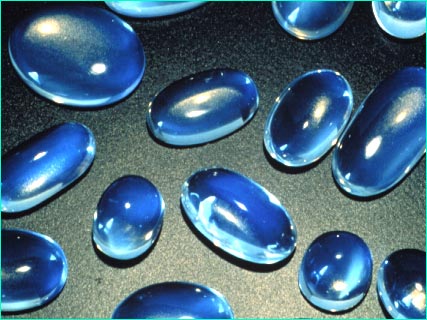June Birthstone
Moonstone
Mohs scale hardness: 6-6.5
Moonstone is a type of feldspar, the most abundant mineral group in the crust of the earth. Feldspars comprise up to 60% of the earth’s crust. Moonstone is composed of potassium aluminium silicate and it is regarded as the most expensive stone of thatt sort of the mineral family. Moonstones are either of the plagioclase feldspar (peristerite) subgroup or the orthoclase feldspar (adularia) subgroup. Moonstones are found in areas of volcanic and hydrothermic activity, it is these conditions that is needed to allow the chemical and physical processes to form the stone.
This mysterious gem, captivating as a full moon gleaming in the night sky, is considered sacred in India, where it has appeared in jewelry for centuries. The gem is also the traditional gift for the 13th wedding anniversary. Moonstones are named because their sheen is similar to moonlight. Moonstone has another synonym, which is Selenite, according to the Greek godess of the moon, Selene.
Moonstone Adularescence
A mesmerizing interplay of light known as schiller or adularescence, causes a silvery-white sheen to glide like veils of mist across the milky surface of the moonstone. Some believe that this moving light is evidence of a living spirit that dwells within the gem. Gemologists, however, attribute the shimmering phenomenon to the presence of albite crystals embedded in feldspar. Moonstone is composed of two feldspar species; orthoclase and albite. Those two are intermingled, then as the newly formed mineral cools, the intergrowth of albite and orthoclase separate into stacked, alternating layers. When light falls between this thin, flat layers, it scatters in many directions producing the phenomenon called adularescense. The word adularescence is derived from the word ‘adularia’, the name used before it came to be known as moonstone.
Colors of Moonstone
Moonstones come in a variety of colors, ranging from colorless to white, yellow, gray, brown, pink, orange and green. Clarity ranges from transparent to translucent. The most sought-after moonstones have a haunting blue sheen, an effect produced by orthoclase feldspar, which is found almost exclusively in stones from SriLanka. Blue-sheen moonstones are increasingly scarce and expensive, especially since the main Sri Lankan deposit of the gems dried up in 1988.
Top quality blue Moonstone displays an incredible “three-dimensional” depth of color, it will be seen clearly only when playfully tilting the stone and moving it. They are very rare and thus highly valuable and coveted. Moonstones' three-dimensional depth of color is called either peristerescence (if the moonstone is from the plagioclase feldspar group)or adularescence (if the moonstone is from the orthoclase feldspar group).
The most well known inclusions found in this stone are known as the centipede-like inclusions, it is the tiny tension cracks which resemble the many-legged creature. Of all the gemstones, only the moonstone is known to have centipede-like inclusions and with the presence of this beautiful inclusions, the price of the stone will go up.
Mined from the earth where plagioclase and orthoclase layers are most abundant, the stones can be found in irregular shapes among other gems, clay debris and gravel. When found in the rough, moonstone is not an impressive sight. Typically, moonstones are cut in the form of cabochon and if cut properly the stone will shimmer and flow. The cutter should bear in mind to locate the axis of the crystal exactly in the zenith of the stone, so that the desired effect of light play will be achieved. Moonstone's delicate beauty and its long heritage make it perhaps the most familiar gem quality member of the feldspar group.
Rainbow Moonstone
One of the most beautiful and adorable kind of moonstone is the one known as rainbow moonstone. Its color is usually gray or white. Light passing over the surface of the stone creates a characteristic bluish iridescent flash. Feldspars are like other igneous stones, they formed when magma, the molten core under the solid crust of the earth, cools and solidifies. The special sheen of rainbow moonstone results from combination of two similar types of feldspar that seperate slightly while the magma is cooling and reflect light differently.
Other gemstones that are closest in appearance to the moonstone are fibrolite, chalcedony and heat-treated synthetic white spinel.
It is believed moonstone have special properties:
- To arouse the passion of lovers.
- If placed beneath the tongue when the moon is full, a moonstone is said to reveal what is in store, good or bad, for a romance.
- Used to protect women and babies.
- Used by females to attract men.
Astrologically, moonstone is associated with the zodiac sign of Gemini.
Copyright © 2009 Game Frog
Home | Contact | Disclaimer | Privacy Policy